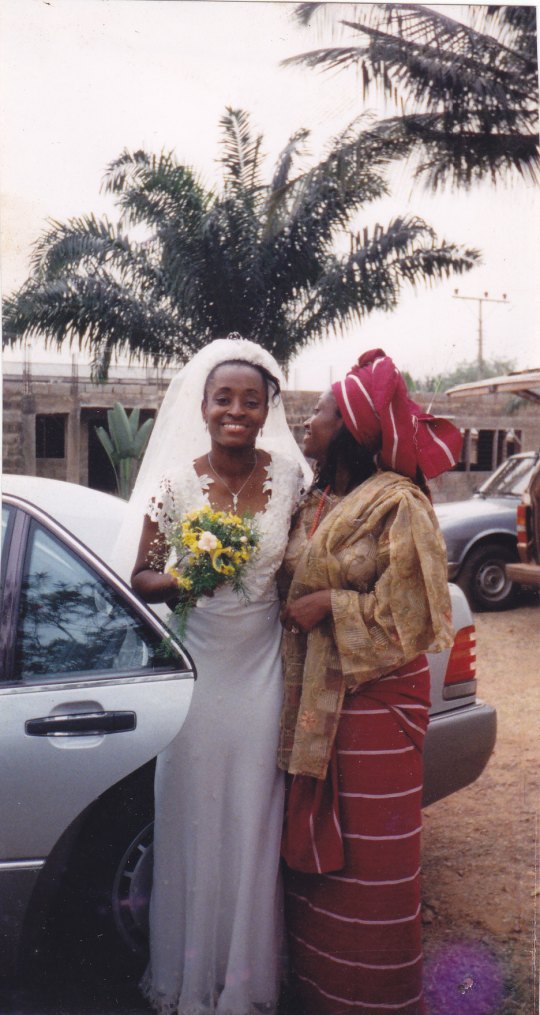This is perhaps the most interesting of the three great classics. Yeah, interesting may be a vague word but it’s the only word that comes to my mind as I write this. Pardon me, I’m going to take a shot at the pronunciation but it’s NOT going to be that accurate: ALA (both ‘A‘s are as in apple) A (also as in apple) RI (the ‘i’ is as in ‘reap’).
Three generations in Alaari: the older couple in classic while the father & son wear one of the modern (generally cheaper weaves) Alaari designs. Christmas 2000.
Basic to this woven cloth style is the red color. The oldest form of Alaari – that is, the classic – generally has a wide red strip and a thin strip in hues of anything pale yellow, off white or even near-khaki that runs in the same direction as the red. Actually, the two classics that are striped – Sanyan and Alaari are woven with strips running in the same direction which the women generally sew in horizontals for the different pieces while the men have their sokoto - pants – sewn in verticals and the other two pieces: the awotele , undergarment, and agbada - big robe – sewn in verticals and horizontals [see below]. The tailors are masters at deciding this but there still seems a general pattern: the bits over the arms are sewn horizontally while the body of the big robes run in the same direction of the sokoto.

Bride & Older Sister, December 1998
However, in not too distant a future, I should have some pictures of a few older woven cloths that may show these design patterns more.
Alaari is interesting because there are variations by sub-ethnic groups of Yoruba people. The most dramatic designs that I’ve seen come from the Egin of Ondo town and environs in present-day Ondo State. The Egin’s Alaari mixes the dominant red with yellows and greens though there are also the dominant red with thin strips of pale yellow or cream. The sub-group can also lay claim to, perhaps, the most distinct woven cloths that mix Etu with bits of very thin dark reds, all of which threads are done at the stage of laying out the threads; the designs are hence already inlaid before weaving. Other Yoruba groups – the “proper” Yoruba of Oyo – also wove variations of these.
Unfortunately, the weaving patterns seem to have died out but very old used ones can be bought at Oje Market, Ibadan, and Oje, Ede – the two dominant markets where Aso Oke can be bought. You can then take these to a very good dry cleaner to get them very clean and fresh. I will post the market days when I return to Ibadan, my real home. That’s where I have a calendar of the market days for 2011. The calendars, not the fanciest thing you would expect from the sources of those incredible aso okeweaves seen around – in fact, they are primitive, pardon me – are sold at the two Oje markets, and since the markets take place every seventeen days, they help me plan trips.
Yeah, I visit them not just to buy but to window shop often, especially the one at Ibadan the way some women visit gold shops! You need Ori (shea butter)? Available at very cheap prices. Or is it our traditional pako (chewing sticks)? Various very good ones are available to supplement your tooth paste which, apart from providing fresh breath, cannot compete with chewing those roots first, rinse, and then follow with your favorite toothpaste. I have a dentist niece who now swears by pako! While dentists may not like this, a combination of the two has kept my visits to dentists over a lifetime to two, one of which was as a result of a dental accident. I do not have a single cavity, nor is any of my ailments tooth-related.

Couple & a set of Parents, December 1998
After this post, I will post a couple of variants of the Alaari on September 29th. Subsequent posts on the subject would come up next year and, hopefully, beyond as I collect pictures from readers and others.

Bride's Parents, December 1998
Dear readers, I present, Alaari, one of the classic cloths made into “clothes [that] wear to shreds”, to borrow Ulli Beier’s description of Yoruba’s classic clothes in “Cloth only wears to shreds: Yoruba textiles & photographs” from Amherst College’s Mead Art Museum. Hopefully, the clothes here will not only outlive the owners but will be passed on from one generation to the next till they become shreds in the tradition of our ancestors. Here is a paragraph from “Letters to my niece”, The Nation on Sunday, February 15, 2009 which was reproduced on this Blog back in May:
“A personal note about the “immortality” of Yoruba cloths: I inherited an iborun & gele set exactly the same design and colors as the one in Fig. 33 from the estate of my mother-in-law who died in 1982. While the Catalog photograph is dated 1984, I believe the cloth must be from a much earlier era. I’ve now used the set as upholstery fabrics. Parts of the gele were in tatters and after being repeatedly told at occasions – as if I did not know – that my gele was “torn”, I woke up one day and decided to cover an old harvest bench, including two small cushions with what could be salvaged from the two pieces. “Timi the Law” (Late Rotimi Williams) who wore his shredded-by-age lawyer’s gown to courts till he died had points to prove; I did not. One of my four kids, though, is already penned down as the next owner of Mama Osogbo’s old aso oke.”
TOLA ADENLE, AKURE, NIGERIA.
September 15, 2011